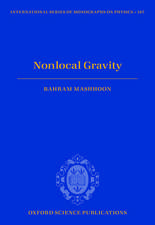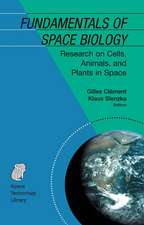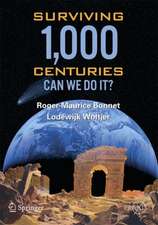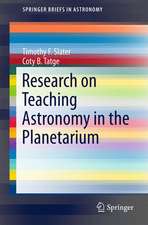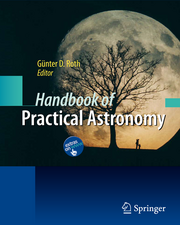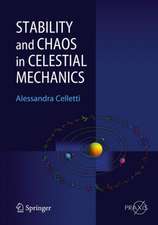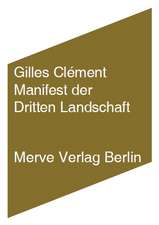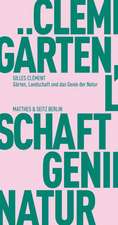Fundamentals of Space Medicine: Space Technology Library, cartea 17
Autor Gilles Clémenten Limba Engleză Paperback – 21 mar 2005
Some results of these investigations have led to fundamental discoveries about the adaptation of the human body to the space environment. Gilles Clément has been active in this research. This readable text presents the findings from the life science experiments conducted during and after space missions.
Topics discussed in this book include: adaptation of sensory-motor, cardio-vascular, bone, and muscle systems to the microgravity of spaceflight; psychological and sociological issues of living in a confined, isolated, and stressful environment; operational space medicine, such as crew selection, training and in-flight health monitoring, countermeasures and support; results of space biology experiments on individual cells, plants, and animal models; and the impact of long-duration missions such as the human mission to Mars. The author also provides a detailed description of how to fly a space experiment, based on his own experience with research projects conducted onboard Salyut-7, Mir, Spacelab, and the Space Shuttle.
Now is the time to look at the future of human spaceflight and what comes next. The future human exploration of Mars capturesthe imagination of both the public and the scientific community. Many physiological, psychological, operational, and scientific issues need to be solved before the first crew can explore the enigmatic Red Planet. This book also identifies the showstoppers that can be foreseen and what we need to learn to fully understand the implications and risks of such a mission.
| Toate formatele și edițiile | Preț | Express |
|---|---|---|
| Paperback (2) | 393.35 lei 6-8 săpt. | |
| SPRINGER NETHERLANDS – 21 mar 2005 | 393.35 lei 6-8 săpt. | |
| Springer – oct 2014 | 786.04 lei 6-8 săpt. | |
| Hardback (1) | 1554.58 lei 6-8 săpt. | |
| Springer – 15 iul 2011 | 1554.58 lei 6-8 săpt. |
Din seria Space Technology Library
- 20%
 Preț: 569.37 lei
Preț: 569.37 lei - 17%
 Preț: 363.73 lei
Preț: 363.73 lei - 20%
 Preț: 476.04 lei
Preț: 476.04 lei - 18%
 Preț: 947.98 lei
Preț: 947.98 lei - 15%
 Preț: 643.99 lei
Preț: 643.99 lei - 18%
 Preț: 1688.57 lei
Preț: 1688.57 lei - 18%
 Preț: 957.75 lei
Preț: 957.75 lei - 18%
 Preț: 1393.27 lei
Preț: 1393.27 lei - 18%
 Preț: 956.03 lei
Preț: 956.03 lei - 15%
 Preț: 647.08 lei
Preț: 647.08 lei -
 Preț: 429.69 lei
Preț: 429.69 lei - 24%
 Preț: 1057.68 lei
Preț: 1057.68 lei - 18%
 Preț: 1215.04 lei
Preț: 1215.04 lei - 24%
 Preț: 810.45 lei
Preț: 810.45 lei - 18%
 Preț: 1009.08 lei
Preț: 1009.08 lei - 18%
 Preț: 955.40 lei
Preț: 955.40 lei - 18%
 Preț: 947.50 lei
Preț: 947.50 lei - 15%
 Preț: 584.92 lei
Preț: 584.92 lei - 15%
 Preț: 647.40 lei
Preț: 647.40 lei - 18%
 Preț: 1834.77 lei
Preț: 1834.77 lei - 15%
 Preț: 590.16 lei
Preț: 590.16 lei - 15%
 Preț: 600.30 lei
Preț: 600.30 lei - 15%
 Preț: 713.33 lei
Preț: 713.33 lei - 23%
 Preț: 739.84 lei
Preț: 739.84 lei - 18%
 Preț: 998.66 lei
Preț: 998.66 lei - 23%
 Preț: 748.98 lei
Preț: 748.98 lei
Preț: 393.35 lei
Nou
Puncte Express: 590
Preț estimativ în valută:
75.27€ • 78.58$ • 62.29£
75.27€ • 78.58$ • 62.29£
Carte tipărită la comandă
Livrare economică 04-18 aprilie
Preluare comenzi: 021 569.72.76
Specificații
ISBN-13: 9781402032462
ISBN-10: 1402032463
Pagini: 361
Ilustrații: XXIV, 361 p.
Dimensiuni: 155 x 235 x 20 mm
Greutate: 0.54 kg
Ediția:2004
Editura: SPRINGER NETHERLANDS
Colecția Springer
Seria Space Technology Library
Locul publicării:Dordrecht, Netherlands
ISBN-10: 1402032463
Pagini: 361
Ilustrații: XXIV, 361 p.
Dimensiuni: 155 x 235 x 20 mm
Greutate: 0.54 kg
Ediția:2004
Editura: SPRINGER NETHERLANDS
Colecția Springer
Seria Space Technology Library
Locul publicării:Dordrecht, Netherlands
Public țintă
ResearchCuprins
to Space Life Sciences.- Space Biology.- The Neuro-Sensory System in Space.- The Cardio-Vascular System in Space.- The Musculo-Skeletal System in Space.- Psycho-Sociological Issues of Spaceflight.- Operational Space Medicine.- Space Life Sciences Investigator’S Guide.
Caracteristici
Successfully makes the connection between space life sciences and medical operations For an understanding of what the space medical community is all about and the real challenges that face the flight surgeon and life science investigator Reflects what we do know in space life sciences at the beginning of the 21st century Points to the missing data, i.e. what we do not know and what we should know before committing to a larger access for humans (i.e., space tourists, by contrast with the current, professional astronauts) in space and for longer duration exploratory missions
Notă biografică
Gilles Clément received Doctoral degrees in Neurobiology from the University of Lyon in 1981 and in Natural Science from the University of Paris in 1986. Dr. Clément is currently Professor of Space Life Sciences in International Space University (ISU), Strasbourg, France. Prior to this position, he was Director of Research from the French National Center for Scientific Research (CNRS), Toulouse, France. Research in space life sciences has been his primary focus with experiments on Salyut-7 (1982), MIR (1988), and on more than 25 Space Shuttle flights (1985 – present). His research topics include influence of microgravity on posture, eye movements, spatial orientation, and cognition in humans. To date, he gathered data on more than 100 astronauts, during and after space missions on the Space Shuttle and the International Space Station. Dr. Clément has written more than 100 peer-viewed research papers in scientific journals. His other books include Fundamentals of Space Biology (Springer, 2006), Artificial Gravity (Springer 2007), and Neuroscience in Space (Springer 2008).
Textul de pe ultima copertă
About 1200 human space flights have been completed to date, including more than 500 astronauts from various countries, for a combined total presence in space of about 90 years. The 21st expedition crew is currently in residence aboard the International Space Station, continuing a permanent presence in space that began in 2000. During that time, investigations have been conducted on both humans and animal models to study bone demineralization, muscle de-conditioning, space motion sickness, changes in immune function, crew and crew-ground interactions, post flight orthostatic intolerance, and the medical issues of living in a space environment, such as the effects of radiation and the risk of developing kidney stones. Results of these investigations have led to fundamental discoveries about the adaptation of the human body to the space environment. Gilles Clément has been active in this research. This book presents in a readable text the findings from life science experiments conducted during and after space missions.
"Fundamentals of Space Medicine, 2nd Edition" looks at the future of human space flight and what comes next. For the next ten years, the ISS will be a fully operational material and life science laboratory with a permanent crew of six astronauts. A new spacecraft named Orion will soon replace the Space Shuttle for transporting humans to the ISS and later to the Moon and Mars. However, many physiological, psychological, operational, and scientific issues need to be solved before establishing manned Moon and Mars bases. Finally, the emerging commercial sub-orbital flight capability captures the imagination of both the public and the scientific community. This book also identifies the showstoppers that are foreseen for all these space missions, and what do we need to learn to understand fullythe implications and risks for space explorers and space tourists.
"Fundamentals of Space Medicine, 2nd Edition" looks at the future of human space flight and what comes next. For the next ten years, the ISS will be a fully operational material and life science laboratory with a permanent crew of six astronauts. A new spacecraft named Orion will soon replace the Space Shuttle for transporting humans to the ISS and later to the Moon and Mars. However, many physiological, psychological, operational, and scientific issues need to be solved before establishing manned Moon and Mars bases. Finally, the emerging commercial sub-orbital flight capability captures the imagination of both the public and the scientific community. This book also identifies the showstoppers that are foreseen for all these space missions, and what do we need to learn to understand fullythe implications and risks for space explorers and space tourists.

